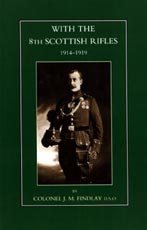Description
Title: With The 8th Scottish Rifles 1914 – 1919
Author: Colonel J Findlay
Condition: Mint
Edition: 2nd Edition
Publication Date: 2002
ISBN: 9781843427407
Cover: Soft Cover without Dust Jacket – 240 pages
Comments: The history of a Territorial battalion that saw action at Gallipoli, in Egypt, Palestine and on the Western Front, and marched into Germany with the Army of Occupation.
The 8th Battalion Scottish Rifles (Cameronians), which was based in Glasgow, was part of the Scottish Rifle Brigade (later 156th), Lowland Division (later 52nd). In May 1915 it sailed, with the division, for Gallipoli where it landed on 14th June. During the fighting at Gully Ravine only two weeks after landing the battalion lost 25 officers and 448 men; only four of the officer casualties ever returned to serve with the battalion.
Following the action the 7th Battalion (which had also suffered heavily) and the 8th formed a composite battalion which was eventually taken off the Peninsula on 9th January 1916 and went to Egypt, where, after a few weeks, it was reorganized into the two battalions. The division took over part of the Suez Canal Defences and in August 1916 the battalion fought in the battle of Romani in which its casualties totalled 3 officers and 31 other ranks.
Subsequently the battalion fought in Palestine at the battles of Gaza and took part in operations leading to the capture of Jerusalem. In April1918 the 52nd Division was sent to France and in June the battalion was transferred to the re-constituted 34th Division (103rd Brigade) with which it took part in the Advance to Victory.
After the armistice the 34th Division was selected for the march into Germany and with it went the 8th Scottish Rifles. The author, who commanded the battalion from June 1917, originally intended this to be an official history of the 8th Scottish Rifles, but he found the records were not complete, in addition to which friends and colleagues were suggesting that a personal touch would make the book more interesting and acceptable to the prospective readers, and that is how he wrote it.
This is apparent in the observations and criticisms he makes which would have been out of place in an official version. In a series of appendices there is a very brief account of the second and third line battalions, neither of which went on active service.
The roll of officers, by companies, who embarked with the battalion for Gallipoli is given as is the Roll of Honour, the summary of casualties (1976 in all of whom 628 were dead), and the list of Honours and Awards.





